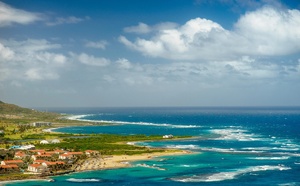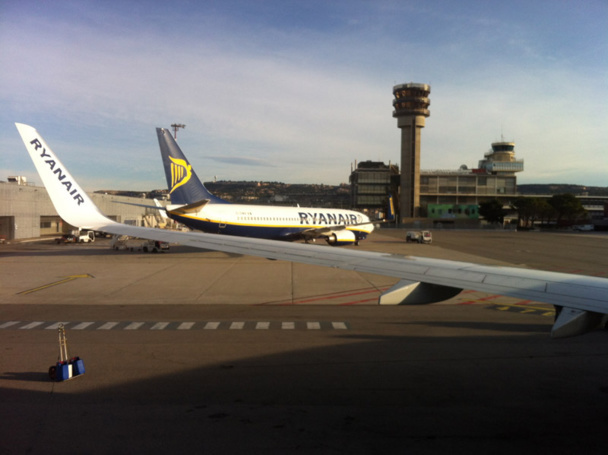
The Ryanair concept that pushed the low-cost model to the extreme, transformed things in the European skies, and the tourism industry - Photo CE.
“Ryanair is an incredible economic success, that changed everything in the sector of air transport and tourism. There is a “before” and an “after” Ryanair, it’s a bit like the Google of air transport” summarizes Fabrice Dariot, CEO of BDV.fr on the low-cost company’s story.
It’s undeniable, in 30 years, the company has shaken up the face of the tourism industry.
But how did it get there? Flashback.
Ryanair is born in 1985 in Dublin.
Created by Thomas Anthony “Tony” Ryan, an Irish businessman, and in collaboration with Liam Lonergan, owner of the tour operator “Club Travel”, the company first operates only one flight between Dublin (Waterford) and London (London Gatwick.)
Two years later, the transporter opens a second line between Dublin and the Luton International Airport in London. It stands as direct competition to Aer Lingus, the national Irish company.
And passengers have been showing up (82,000 right on the first year on both lines with 2 aircrafts.)
The attendance keeps increasing, but the success isn’t as easily reflected in the accounts, and the benefits appear very slowly.
So Tony Ryan calls for the services of Michael O’Leary. This is in 1998, the future CEO of Ryanair is less than 30 years old, and he becomes the company’s advisor.
It’s undeniable, in 30 years, the company has shaken up the face of the tourism industry.
But how did it get there? Flashback.
Ryanair is born in 1985 in Dublin.
Created by Thomas Anthony “Tony” Ryan, an Irish businessman, and in collaboration with Liam Lonergan, owner of the tour operator “Club Travel”, the company first operates only one flight between Dublin (Waterford) and London (London Gatwick.)
Two years later, the transporter opens a second line between Dublin and the Luton International Airport in London. It stands as direct competition to Aer Lingus, the national Irish company.
And passengers have been showing up (82,000 right on the first year on both lines with 2 aircrafts.)
The attendance keeps increasing, but the success isn’t as easily reflected in the accounts, and the benefits appear very slowly.
So Tony Ryan calls for the services of Michael O’Leary. This is in 1998, the future CEO of Ryanair is less than 30 years old, and he becomes the company’s advisor.
Michael O’Leary imposes his “low cost” model
Autres articles
-
 Justice : Ryanair condamnée, que faut-il retenir du jugement ?🔑
Justice : Ryanair condamnée, que faut-il retenir du jugement ?🔑
-
 Droit de réponse : Ryanair - agences : vers un réchauffement des relations ?
Droit de réponse : Ryanair - agences : vers un réchauffement des relations ?
-
 Ryanair - agences : vers un réchauffement des relations ? 🔑
Ryanair - agences : vers un réchauffement des relations ? 🔑
-
 Ryanair : comment Michael O'Leary a été entarté par des manifestants !
Ryanair : comment Michael O'Leary a été entarté par des manifestants !
-
 Grève des contrôleurs aériens : Ryanair interpelle la Commission européenne
Grève des contrôleurs aériens : Ryanair interpelle la Commission européenne
Drastic measures were taken to reduce costs: quicker rotation of aircrafts, no more business class, free additional services onboard, the use of only one type of aircraft to reduce maintenance costs and running from secondary airports.
Without forgetting savings on the employee base: difficult working conditions and contracts under Irish law that were subject of various lawsuits. (An article on this topic on Friday.)
Michael O’Leary rises in the ranks, he becomes deputy CEO (from 1991 to 1994) and then CEO (in January 1994.)
In 1992, the deregulation of air trafic in Europe opens up a new playing ground and offers new development perspectives.
Little by little, Ryanair expands and establishes bases in Europe: Stockholm, Oslo, Brussels Charleroi, Frankfurt, Milano, Bergamo or even Marseille and Paris-Beauvais in France.
Its business model bases itself partially on the public funding it receives which led to an investigation by the European Commission.
As a reminder: in July 2014, the European Commission asked Ryanair to pay back 9.6 million euros of help for the Pau Airports (€2.4 million), Nîmes (€6.4 million) and Angoulême (€868,000.)
The company takes all opportunities but doesn’t hesitate to shut down lines that don’t quickly have a satisfying occupancy rate.
The Ryanair concept extended the horizon of air transport.
“They went to the extreme of the low-cost model in terms of internal management, and of the client. The company showed that air transport could bring lots of benefits.
It also expanded the idea that we could use European regulation to the profit of the company but not necessarily to the advantage of employees, or clients,” analyzes Jean-Louis Baroux, President of APG, and he adds “it’s an incredible success, that is extremely irritating.”
By extension, it also changed the playing field of the entire tourism industry. All of the levels of the industry were impacted by this low-cost wave. Tour-operators and travel agencies were not exempt from the rule.
Without forgetting savings on the employee base: difficult working conditions and contracts under Irish law that were subject of various lawsuits. (An article on this topic on Friday.)
Michael O’Leary rises in the ranks, he becomes deputy CEO (from 1991 to 1994) and then CEO (in January 1994.)
In 1992, the deregulation of air trafic in Europe opens up a new playing ground and offers new development perspectives.
Little by little, Ryanair expands and establishes bases in Europe: Stockholm, Oslo, Brussels Charleroi, Frankfurt, Milano, Bergamo or even Marseille and Paris-Beauvais in France.
Its business model bases itself partially on the public funding it receives which led to an investigation by the European Commission.
As a reminder: in July 2014, the European Commission asked Ryanair to pay back 9.6 million euros of help for the Pau Airports (€2.4 million), Nîmes (€6.4 million) and Angoulême (€868,000.)
The company takes all opportunities but doesn’t hesitate to shut down lines that don’t quickly have a satisfying occupancy rate.
The Ryanair concept extended the horizon of air transport.
“They went to the extreme of the low-cost model in terms of internal management, and of the client. The company showed that air transport could bring lots of benefits.
It also expanded the idea that we could use European regulation to the profit of the company but not necessarily to the advantage of employees, or clients,” analyzes Jean-Louis Baroux, President of APG, and he adds “it’s an incredible success, that is extremely irritating.”
By extension, it also changed the playing field of the entire tourism industry. All of the levels of the industry were impacted by this low-cost wave. Tour-operators and travel agencies were not exempt from the rule.
Ryanair and disintermediation
“Beyond Ryanair, its the model that had an impact and that forced other companies to work on the same pattern.
The low cost trend contributed to the transformation of the economic model of charters. Before, TOs would work with an entire plane.
Today, they only reserve a section of the aircraft, which enables to better manage the flying risk. This is the advantage” explains René-Marc Chikli President of SETO.
But there are also some disadvantages: first, that of the disintermediation”, he adds.
With the rise of low-cost transporters, clients have learned to handle things on their own, creating their touristic packages autonomously, hurting the role of TOs and travel agencies.
“On some products such as City Breaks, we were the leaders, and now we’re forced to share” observes the President of SETO.
“This contributed in turning our direct clients into competitors. Our profession had to change with the trend” adds Jean-Pierre Mas President of SNAV.
The low cost trend contributed to the transformation of the economic model of charters. Before, TOs would work with an entire plane.
Today, they only reserve a section of the aircraft, which enables to better manage the flying risk. This is the advantage” explains René-Marc Chikli President of SETO.
But there are also some disadvantages: first, that of the disintermediation”, he adds.
With the rise of low-cost transporters, clients have learned to handle things on their own, creating their touristic packages autonomously, hurting the role of TOs and travel agencies.
“On some products such as City Breaks, we were the leaders, and now we’re forced to share” observes the President of SETO.
“This contributed in turning our direct clients into competitors. Our profession had to change with the trend” adds Jean-Pierre Mas President of SNAV.
Opening to travel agencies
But in the business world, nothing remains stagnant. “The ostracism towards travel agencies and OTA is now less and less as Ryanair now turns to GDS,” insures Fabrice Dariot.
The company that used to only function through the direct sales of its plane tickets is starting to change its strategy.
“Despite past declarations made by Michael O’Leary who compared travel agencies to “deadwood”, the company is starting to reach out to distribution networks.
He thought that working with agencies came with a cost, but today he realizes that distribution leads to profit margin that is much higher than the costs,” specifies Jean-Pierre Mas.
Since March 2014, Ryanair appears on Travelport. And Since September 2014, on Amadeus.
Another sign that the times are changing: the company is now trying to seduce business travelers.
For doing so, it is targeting the main platforms of European capitals: Rome-Fiumicino, Brussels-Zaventem or Barcelona-El Prat.
It seems that on the eve of its 30th year anniversary, the company decided to undertake a strategic turn to look for new growth possibilities.
The company that used to only function through the direct sales of its plane tickets is starting to change its strategy.
“Despite past declarations made by Michael O’Leary who compared travel agencies to “deadwood”, the company is starting to reach out to distribution networks.
He thought that working with agencies came with a cost, but today he realizes that distribution leads to profit margin that is much higher than the costs,” specifies Jean-Pierre Mas.
Since March 2014, Ryanair appears on Travelport. And Since September 2014, on Amadeus.
Another sign that the times are changing: the company is now trying to seduce business travelers.
For doing so, it is targeting the main platforms of European capitals: Rome-Fiumicino, Brussels-Zaventem or Barcelona-El Prat.
It seems that on the eve of its 30th year anniversary, the company decided to undertake a strategic turn to look for new growth possibilities.








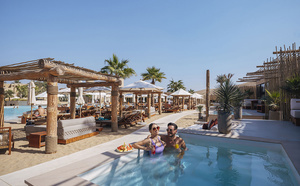







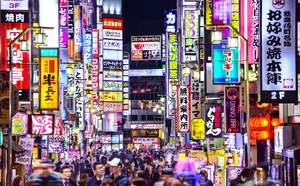
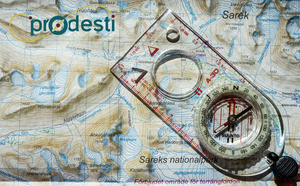





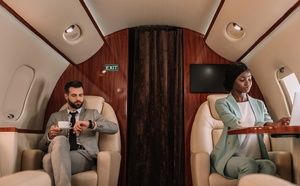
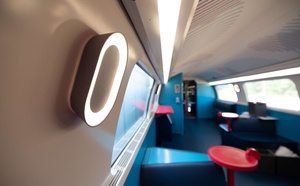



![Lire ou pas ? Le secteur touristique à un rôle à jouer ! [ABO] Lire ou pas ? Le secteur touristique à un rôle à jouer ! [ABO]](https://www.tourmag.com/photo/art/large_16_9/88094660-62395447.jpg?v=1745418480)

